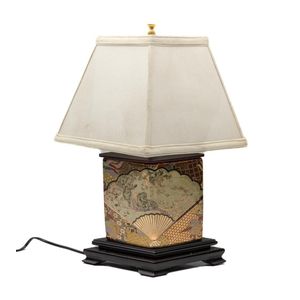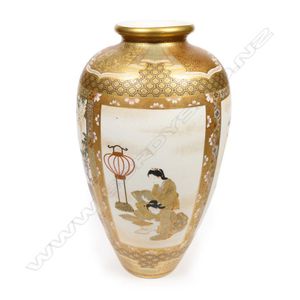
Japanese Satsuma Ceramic and Timber Table Lamp, 43 cm Height
A Japanese satsuma ceramic and timber table lamp, height 43 cm (untested)

Meiji Period Satsuma Table Lamp with Bird and Flower Design
A Japanese Satsuma Meiji period table lamp. Painted with birds nesting in flowering trees intersected by panels with a diaper pattern flower design. Raised on a fitted wooden stand. 55 cm height (including shade)

Satsuma Japanese Pottery Table Lamp with Ormolu Mounts, Meiji Period
Satsuma Japanese pottery table lamp with French ormolu mounts, Meiji period, early 20th century, 74 cm high overall

Satsuma Yaki Quail Landscape Table Lamp
A Satsuma table lamp, Satsuma Yaki mark, mid to late 20th century, the lobed ceramic vase hand painted and gilded with quails in continuous landscape with floral sprays and reeds, in muted green and purple tones against a cream crackle glazed ground, with…

Japanese Satsuma Vase with Alpine River Landscape and Monkeys
A fine Japanese Satsuma earthenware vase, by Toyama, ovoid shape, with four panels painted with and alpine river landscape; birds beneath wisteria; women reading beside a lamp and monkeys playing in a blossom tree, framed by various gild and enamel diaper…

Satsuma Earthenware Table Lamp, 19th Century
An antique Satsuma earthenware vase converted into a table lamp, 19th century, the vase 43 cm high, 60 cm overall

Japanese Satsuma Double Gourd Table Lamp with Birds and Flowers
A Japanese Satsuma double gourd table lamp featuring birds and flowers on a crackle glazed ground, height 52 cm Pass tag from electrical tester dated 29/06/2022 on lead

Japanese Satsuma Figural Lamp on Timber Stand
Japanese Satsuma figural electric lamp base on a timber stand, height 49 cm

Satsuma Pheasant Table Lamp
A Japanese Satsuma style table lamp; the ovoid body decorated with pheasants amongst flowers. Height 62 cm

Bronze Satsuma Oil Lamps with Electric Conversion
A pair of bronze mounted Satsuma oil lamps with electric conversion, Meiji period, 1968-1912, 19th century Kosmos wild & Wessel (Berlin), the pair both finely decorated with two shaped reserves featuring figural narratives set in gardens and interiors…

Japanese Satsuma Pottery Electric Lamp
Antique Japanese Satsuma pottery vase converted to an electric lamp, vase height 30.5 cm, total 59 cm

Japanese Satsuma Guan Yin Lamp Base with Base Loss
Early Japanese Satsuma Guan Yin lamp base height 38 cm, loss to base

Royal Satsuma Floral Lamps with Shades - 73cm Height
A pair of Royal Satsuma floral design lamps with shades, height 73 cm

Royal Satsuma Elephant Lamps with Shades - 60cm Height
A pair of Royal Satsuma elephant pattern lamps with shades, height 60 cm

Japanese Satsuma Table Lamp with Pagoda Shade
A Japanese Satsuma table lamp, of cylindrical shape with pierced and painted decoration, with a pagoda shade. Height 62 cm

Japanese Satsuma Village Scene Lamp
Large Japanese Satsuma vase mounted as a lamp with gilt and fine detail depicting Japanese gentleman, ladies and children, in a village scene on a crackle glaze underlay, with gilt metal base and top., height 72 cm

Satsuma Goddess Elephant Lamp Base
Early 20th century Satsuma lamp base modelled as a goddess on elephant, heavy enamel decorations, 35 cm height

Antique Satsuma Lamp Bases on French Bronze Bases
A pair of antique Satsuma lamp bases, mounted on French bronze bases, circa 1880. Total height 61 cm
![A tall pair of Japanese Satsuma vases, Meiji period [1868-1912],…](https://img.carters.com.au/300x300/895f8c56ec32e359ead3d5aef4017be2.jpg)
Satsuma Samurai Vases with Enamel & Gilt Detailing
A tall pair of Japanese Satsuma vases, Meiji period [1868-1912], painted in fine detail with raised enamel & gilt of samurai warriors, children at play & landscape within shaped cartouche between bands of brocade designs, condition: Restoration to one rim…

Satsuma Vase Lamps - Vintage Pair, 42cm High
Pair of old Satsuma vases converted into lamps, each approx 42 cm high, (2)

Meiji Satsuma Lamp with Shade
A Japanese Satsuma lamp base with shade Meiji period 1868 - 1912. Height (with shade)

Satsuma Karako Children Kerosene Lamp
A 19th century Japanese Satsuma vase converted to a kerosene lamp, baluster, decorated with karako children, mounted on a brass column, surmounted by a flattened ovoid vaseline glass font, 61 cm high

Satsuma Duck and Cherry Blossom Lamp
Satsuma lamp decorated with a scene of ducks on a lake under a cherry blossom tree. Condition good, minor crazing throughout height 40.5 cm

Satsuma Vases with Lamp Conversion (Pair)
Satsuma pair of vases, one converted to a lamp, approx 38 cm high (2)

Satsuma Moon Flask Vase Lamp with Foo Dog Handles
Satsuma moon flask vase converted to a lamp, with two Japanese Foo dog handles, fine single hair brush gilded paint work throughout, both sides with all over floral design & two panels of pagoda scenes. Height 42.5 cm

Japanese Satsuma Ceramic Lamp Base, Thousand Flower Design
An early 20th century Japanese Satsuma ceramic lamp base, signed, embellished in the thousand flower design 34.5 cm high (not inc shade)


 Loading more...
Loading more...